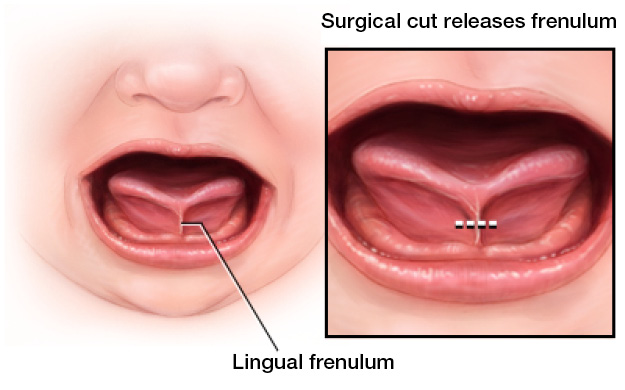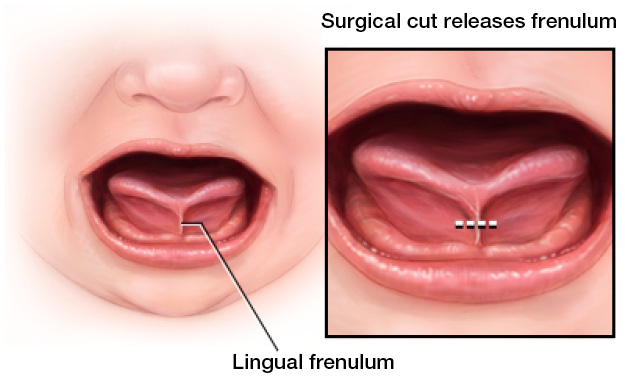



Some people get nervous or have a hard time finding the right words in social or stressful situations. They may say that they were “tongue-tied” in the moment. While this could be an embarrassing or stressful moment, it’s usually temporary. Yet, the term “tongue-tie” also is used to describe a medical condition called ankyloglossia.
Tongue-tie, or ankyloglossia, is when an unusually short, thick or tight band of tissue tethers the bottom of the tongue’s tip to the floor of the mouth. The band of tissue is called the frenulum. When it is too short or tight, it can restrict the tongue’s range of motion. Up to 10% of all newborns are born with ankyloglossia.
 The most common type of tongue tie affects the anterior frenulum, which is visible near the front of the tongue. Research studies are exploring posterior tongue-tie, which is when the frenulum is restricted further back underneath the tongue.
The most common type of tongue tie affects the anterior frenulum, which is visible near the front of the tongue. Research studies are exploring posterior tongue-tie, which is when the frenulum is restricted further back underneath the tongue.
The most common symptom of tongue tie in newborns is difficulty with breastfeeding or bottle-feeding. This is because a baby must be able to get the tongue to the roof of the mouth to squeeze the nipple and express milk while feeding. If a tongue has a limited range of motion, the child can’t create a good seal and is less effective with expressing milk from the bottle or nipple and pushing it to the back of the mouth to initiate the swallowing mechanism.
When newborns have a posterior tongue tie, they may be able to protrude their tongues past their gums, but the tongue is tethered further back and causes feeding or swallowing issues.
Latching and feeding challenges can be caused by various issues, not just tongue-tie. It’s important to rule out other causes before seeking tongue-tie treatment. Additional issues could include a recessed jaw, infection, jaundice, poor positioning, engorgement or others.
Some people are diagnosed later in life, especially if the tongue-tie wasn’t significant enough to cause breastfeeding issues in infancy. Teens often are diagnosed with tongue-tie after expressing concerns and becoming self-conscious about their tongues as they become involved in romantic relationships.
Tongue tie does not cause sleep apnea or snoring.
Not all people with tongue-tie require treatment. Some health care professionals recommend treating it right away, while others take a wait-and-see approach. Otorhinolaryngology, or ear, nose and throat, professionals work in concert with lactation consultants and speech therapists to recommend the right treatment option for each patient.
If treatment is recommended, a frenotomy is a quick, low-risk procedure to correct tongue-tie. In an office setting, a laser or sterile scissors is used to snip the frenulum free. The healing time is quick, with minimal pain and blood loss.
The risks for the procedure are low. However, your health care team must carefully avoid the glands, ducts and nerves located under the tongue to prevent injury, especially if treating a posterior tongue tie.
As a person grows and develops, tongue anatomy does not change. People will not grow out of the condition, but most learn to manage the symptoms as they age. For example, having tongue-tie can be a problem for newborns who rely on breastfeeding. Adults have little or no issues with eating because they can cut up food into smaller pieces and place food further back into the mouth using a utensil. Speech therapy can help with letter sounds and pronunciation.
Talk to your child’s pediatrician or otorhinolaryngology professional if you have tongue-tie concerns or questions.





